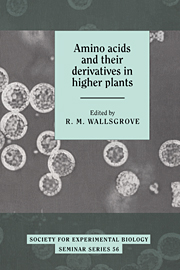Book contents
- Frontmatter
- Contents
- List of contributors
- Preface
- Glutamine synthetase in higher plants: molecular biology meets plant physiology
- Interactions of nitrogen and carbon metabolism: implications of PEP carboxylase and isocitrate dehydrogenase
- The genetics of aspartate derived amino acids in higher plants
- Oxidation of 1-aminocyclopropane-1-carboxylic acid (ACC) in the generation of ethylene by plants
- Regulation of carbon flow through the branched chain amino acid biosynthetic pathway
- Amino acid metabolism and protein deposition in the endosperm of wheat: synthesis of proline via ornithine
- The glycine decarboxylase complex in higher plant mitochondria: structure, function and biogenesis
- Glycine and serine synthesis in non-photosynthetic tissues
- Biogenesis of N-heterocydic amino acids by plants: mechanisms of biological significance
- Toxicity of non-protein amino acids from plants
- Processes involved in glutathione metabolism
- Betaines in higher plants – biosynthesis and role in stress metabolism
- Metabolism and function of polyamines during osmotically induced senescence in oat leaves and protoplasts
- Biosynthesis of cyanogenic glucosides. Elucidation of the pathway and characterization of the cytochromes P-450 involved
- The biosynthesis of glucosinolates in Brassicas
- Biochemical genetics of aliphatic glucosinolates in Brassica and Arabidopsis
- Index
Amino acid metabolism and protein deposition in the endosperm of wheat: synthesis of proline via ornithine
Published online by Cambridge University Press: 09 April 2010
- Frontmatter
- Contents
- List of contributors
- Preface
- Glutamine synthetase in higher plants: molecular biology meets plant physiology
- Interactions of nitrogen and carbon metabolism: implications of PEP carboxylase and isocitrate dehydrogenase
- The genetics of aspartate derived amino acids in higher plants
- Oxidation of 1-aminocyclopropane-1-carboxylic acid (ACC) in the generation of ethylene by plants
- Regulation of carbon flow through the branched chain amino acid biosynthetic pathway
- Amino acid metabolism and protein deposition in the endosperm of wheat: synthesis of proline via ornithine
- The glycine decarboxylase complex in higher plant mitochondria: structure, function and biogenesis
- Glycine and serine synthesis in non-photosynthetic tissues
- Biogenesis of N-heterocydic amino acids by plants: mechanisms of biological significance
- Toxicity of non-protein amino acids from plants
- Processes involved in glutathione metabolism
- Betaines in higher plants – biosynthesis and role in stress metabolism
- Metabolism and function of polyamines during osmotically induced senescence in oat leaves and protoplasts
- Biosynthesis of cyanogenic glucosides. Elucidation of the pathway and characterization of the cytochromes P-450 involved
- The biosynthesis of glucosinolates in Brassicas
- Biochemical genetics of aliphatic glucosinolates in Brassica and Arabidopsis
- Index
Summary
Background
Between 75% and 85% of the mature wheat grain is starch, so above all else, yield is a measure of the whole-plant processes that culminate in starch deposition in the grain. Protein percentage, on the other hand, is a ratio value, and whilst not independent of yield is obviously an expression of nitrogen metabolism. The rates and durations of both starch and protein deposition in the endosperm of wheat all appear to be independent events controlled by separate mechanisms (Jenner, Ugalde & Aspinall, 1991). It is this independence that gives the opportunity to manipulate specific responses in the plant that culminate in starch and protein deposition, whether the attempts at improvement be genetic or agronomic.
The relationship between substrate supply and dry matter deposition is different for starch and protein, and the responses change during grain development (Jenner et al, 1991). During the grain filling stage (10–15 days after anthesis until the onset of maturity), the rate of starch deposition in healthy plants is mainly influenced by sink-limited factors, that is by factors that operate within or close to the grain itself. By contrast, deposition of protein is influenced to a much greater extent by source-limited factors, that is by factors of supply. Increasing amino acid supply to developing grains leads directly to increases in protein deposition. Within this context, however, the levels of substrate within the endosperm (sucrose and amino acids respectively) appear inconsistent with what may be expected.
- Type
- Chapter
- Information
- Amino Acids and their Derivatives in Higher Plants , pp. 77 - 86Publisher: Cambridge University PressPrint publication year: 1995



